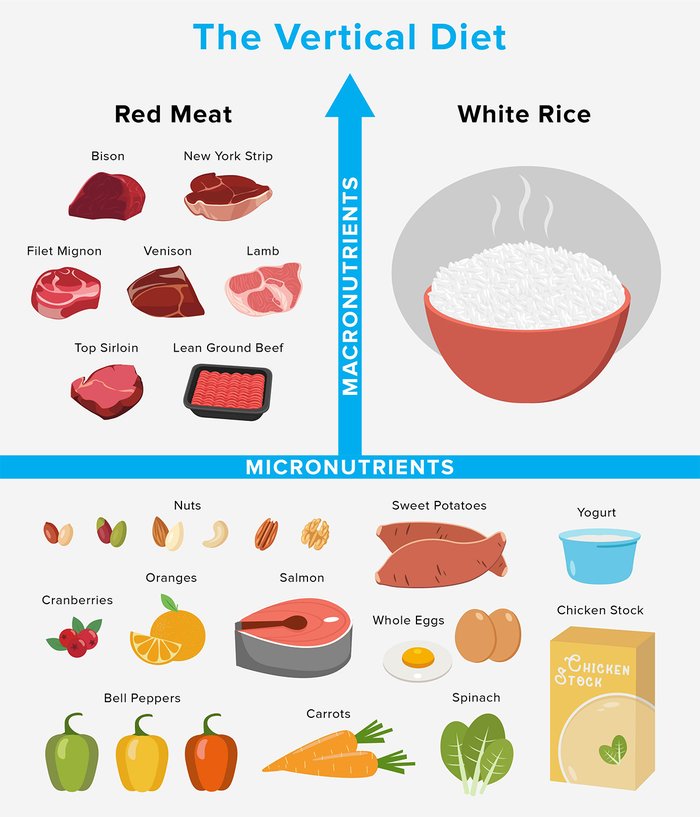There's a plethora of diets out there, each with its own unique list of what and what not to eat. And in many cases, let's face it, the "what not" can seem way bigger. This can leave high-level strength athletes in a quandary: How do they prioritize whole foods while still eating enough to meet the demands of high-intensity training and competition?
As someone who has competed at the highest levels of both powerlifting and bodybuilding, Stan "The White Rhino" Efferding knew this problem as well as anyone. In response, this IFBB pro bodybuilder, former Mr. Olympia competitor, and raw powerlifting record holder created the Vertical Diet. What started out as Efferding's personal approach to eating has caught fire, allowing some of the world's best strength athletes to consume the massive calories and nutrients their sports demand to increase strength output and muscle mass—all without sacrificing digestion.
So is the Vertical Diet right for you? We talked with the White Rhino himself, so let's dig deeper and find out!
What is the Vertical Diet?
As Efferding explains, the Vertical Diet has two levels: The micro, and the macro.
"It's a performance-based nutritional framework that starts with a solid foundation of highly bioavailable micronutrients," he explains. "This supports a structure of easily digestible macronutrients that can be adjusted specifically to meet your body's demands."

The diet gets its name from its vertical structure, which looks a lot like an upside-down uppercase T. The horizontal base of the model prioritizes nutrient-packed foods such as:
- fresh fruit (Efferding prioritizes oranges and cranberries)
- nuts
- vegetables (carrots and peppers are quite prominent)
- yogurt
- spinach
- whole eggs
- stock and bone broth
- fatty fish like salmon
- sweet potatoes
The "vertical" component of the diet is built on the premise that as your digestive system adapts and becomes more efficient, you'll be able to take in greater quantities of other foods to increase strength and improve recovery. Specifically, Efferding prioritizes white rice and white potatoes for carbs, and red meat like bison, steak, and lamb for protein.
Efferding's favorite meal is his"monster mash." This consists of ground bison, white rice, spinach, and peppers all cooked in bone broth. "It's delicious, easy to digest, and feels great on the stomach," he says.
It's important to note here that store-bought, packaged ground beef or bison is not the same as a whole steak in the Vertical Diet. Efferding says consuming whole cuts of meat ensures higher quality calories—hamburger meat is often made from scraps, after all—and provides more vitamins, minerals, and fats than processed ground meat. That said, if you can have a butcher grind up steak for you, or you own a grinder yourself, you should go for it.
The best way to describe the Vertical Diet is to explain who it was designed for. The Vertical Diet was developed as a performance diet intended for high-level athletes whose sports require them to take in a tremendous amount of food. Think powerlifters with a two-a-day lifting schedule, elite strongman or CrossFit athletes, or bodybuilders adding size in a six-day training split.

For athletes like these, eating enough is only one part of the equation. They need foods that they are able to digest and absorb as much as possible—otherwise, a meal is just a wasted opportunity.
"Your body doesn't use all of the nutrients you consume," Efferding explains. "Some micronutrients pass through and go to waste due to the fact that your body can't assimilate them."
What's Not on the Plate
Food digestion is highly personal, and what makes one person feel awful may be just fine for someone else. Figuring out what that looks like for you will take time, and Efferding encourages anyone interested in the Vertical Diet to follow their body. As he puts it, "I don't eat foods I like, I eat foods that like me."
In the Vertical Diet, the "foods that don't like me" camp includes carb sources that are high in fermentable oligo-, di-, mono-saccharides and polyols, aka FODMAPs. These short-chain carbohydrates are notorious for causing digestive distress in certain people, and are abundant in legumes, brown rice, and many cruciferous vegetables. In the Vertical Diet, they are either limited based on individual response, or prepared in a manner that reduces digestive distress.
While you may look at this list and think to yourself, "Wait a minute, I thought those foods were healthy," understand that the focus here is digestibility. High FODMAP foods contain large amounts of raffinose, a complex sugar that can cause gas and bloating. Limiting these foods should therefore reduce these effects and improve overall digestion.

This isn't to say these foods aren't allowed completely, but Efferding encourages choosing foods that are easily digestible and don't aggravate the gut, such as low-gas vegetables like spinach, cucumbers, bell peppers, and potatoes. That said, highly processed vegetable and seed oils such as corn, cottonseed, canola, safflower, and sunflower oil are strictly avoided.
Start paying attention to how you feel about an hour after you eat something. If you find your favorite foods send your digestive system into distress mode, that's a sign that the foods you like may not like you back. Pay attention to your digestion and gut health, and you might find you feel better without those "comfort" foods!
What if I'm Not an Athlete?
Critics of the Vertical Diet point out that increasing the intake of only a few select foods could limit total micronutrients. Some nutritionists say that due to its emphasis on increasing caloric intake and prioritizing fast-digesting carbs and red meat, it should really only be followed by professional powerlifters and strongmen.
However, Efferding points out that the real strength of this diet is adherence. Most diets fail due to excessive hunger or loss of energy, and the Vertical Diet is designed specifically to combat these pitfalls. Yes, it may work best for high-level athletes, but the core principles are applicable to everyday people, too.
"There have been thousands of Vertical Diet clients who have regulated their blood sugars, lowered their blood pressure, improved their cholesterol, digestion, and general health all with this way of eating,” Efferding explains. "Certainly, there are many influencing factors when reaching a goal, including hormones, adaptation, and food metabolism. It's not a 'cookie-cutter' approach. Those who want to lose weight maintain a calorie deficit and those who want to gain weight maintain a calorie surplus."

Efferding also points out that the introductory phase of the diet is the most limited part, and it's not meant to last forever. Sleep, hydration, and exercise are all key components of this approach, all of which can help stimulate metabolism and optimize hormones to improve results.
The Bottom Line
The primary goal should always be to try to make any nutritional choices become a part of a healthy lifestyle. If the Vertical Diet sounds like something you can easily stick to, and your goals are to increase performance and feel better, then try it for yourself.
The Upsides:
- You won't be forced to eliminate entire macronutrients from your diet.
- It is easily customizable for performance goals.
- It gives you the opportunity to determine which foods treat your digestive system well, and which ones don't.
The Downsides:
- It is fairly limited and potentially repetitive.
- Eating red meat frequently can get expensive quickly.
- Many nutritionists aren't a fan of eating large quantities of red meat.
Just be warned, if you're not willing to invest in yourself with optimal sleep and regular exercise, it's unlikely that this diet will get you the results you're looking for! To learn more, check out TheVerticalDiet.com.
For a complete education in fitness nutrition, check out Bodybuilding.com's Foundations of Fitness Nutrition course, only on Bodybuilding.com BodyFit Elite. In nine videos, two experienced dieticians will tell you everything you need to know to build muscle, burn fat, and eat for health!

